Table Of Contents
- The Quiet Revolution of October Weather
- Osaka Castle: More Than Just History
- Temple Gardens: Osaka's Spiritual Autumn
- Minoo Park: Where Waterfalls Meet Autumn Fire
- Hoshida Park: Engineering Meets Nature
- Hidden Japanese Gardens: Autumn's Intimate Stages
- Street Food Season: Autumn's Culinary Shift
- Quiet Neighborhoods: Autumn's True Character
- Green Tea Culture: Autumn's Ceremonial Side
- Elevated Views: Autumn from Above
- Day Trip Destinations: Autumn Beyond the City
- Timing Your Autumn Experience
- Autumn Photography: Capturing Ephemeral Beauty
- What to Pack: Layering for Autumn Comfort
- Festival Culture: Autumn's Cultural Celebrations
- Evening Autumn: When Osaka Glows
- Finding Solitude: Quiet Spaces in Busy Osaka
- Universal Studios and Ghibli Park: Autumn Theme Park Magic
- Transportation: Moving Through Autumn Osaka
- The Art of Autumn Appreciation
- Autumn's Hidden Stories
- Weather Wisdom: Understanding Autumn's Rhythms
- Conclusion: Embracing Autumn's Secret Season
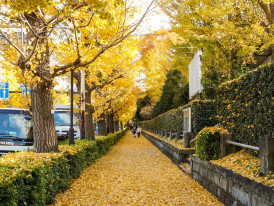
A tree-lined street in Osaka with ginkgo trees and fallen golden leaves on sidewalks with light foot traffic Photo by Maggie Hung on Unsplash
There's something almost conspiratorial about autumn in parts of Osaka Prefecture. While spring draws crowds chasing cherry blossoms and summer pulses with festival energy, fall arrives quietly, transforming the city into something softer, more contemplative. I've lived in this corner of Japan for fifteen years, and every October still surprises me with its gentle revelations.
The tourists thin out after the summer heat breaks, leaving space for locals to reclaim favorite spots. Temperatures ranging from crisp mornings to pleasant afternoons create perfect conditions for wandering. This is when Osaka shows its truest face—something deeper, more nuanced than tourist brochures suggest.
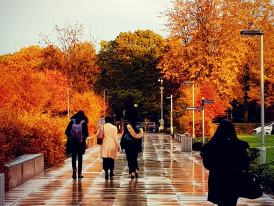
Early morning commuters walking through fallen autumn leaves near Namba Station Photo by Catherine Feather on Unsplash
The Quiet Revolution of October Weather
When people ask about visiting Osaka, they usually picture cherry blossom season or summer festivals. But autumn in this part of Osaka Prefecture offers something different entirely. The humidity that defines summer gradually lifts, leaving behind air that feels clean and sharp.
I remember my first October here, stepping out from Osaka Station into morning air that actually felt breathable. After months of summer's oppressive heat, the city suddenly became walkable again. Streets that had felt impossibly crowded during peak tourist season now offered space to breathe.
Mid-October brings the best balance—warm enough for light layers, cool enough that a short walk doesn't leave you seeking air conditioning. By November, you'll want a proper jacket, but the transition happens gradually. The weather creates perfect conditions for slow exploration that visiting Osaka deserves. You can spend a couple of hours wandering temple grounds without wilting, or take that day trip to hidden gems without feeling rushed.
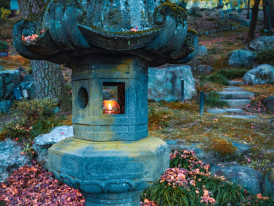
A traditional Japanese garden corner within the castle grounds showing a stone lantern surrounded by colorful leaves Photo by S. Tsuchiya on Unsplash
Osaka Castle: More Than Just History
Everyone knows Osaka Castle Park, but most visitors see it wrong. They rush up for photos, check it off their list, and move on. Autumn reveals why this place has anchored the city for centuries.
The castle grounds transform completely when autumn leaves begin their slow burn. What looks like simple parkland in summer becomes a layered tapestry of color. The official entrance gets crowded, but if you enter through the eastern gate near Morinomiya Station, you'll find quieter paths that wind through some of the best fall foliage in central Osaka.
I often bring my morning green tea here, finding a bench near the western edge where ginkgo trees create a golden canopy. The castle itself becomes secondary to the way light filters through changing leaves. This is when you understand why this spot was chosen—not just for strategic advantage, but for its natural beauty.
Osaka Castle Park in autumn offers layers of discovery. Beyond the main structure, there are hidden corners where autumn foliage creates intimate spaces. The plum grove sits quietly beside groves of maple that glow like lanterns. The view from the castle's observation deck reveals a city softened by fall foliage, less harsh than summer's concrete glare.
Fun fact: The original Osaka Castle was built with wood from forests across Japan, each prefecture contributing trees. Today's reconstruction uses modern materials, but the surrounding trees create the forest atmosphere the original builders would have known.
Looking for a private city experience in Osaka?
Explore the city with a local who plans a private day just for you; no groups, no scripts.

A traditional tea ceremony setup on tatami mats with autumn leaves visible through open shoji screens
Temple Gardens: Osaka's Spiritual Autumn
The ji temple complexes scattered throughout Osaka become sanctuaries in autumn. Not the grand temples that tour buses visit, but smaller places where neighborhood residents come for quiet reflection.
I discovered my favorite ji temple by accident, following a narrow alley behind a convenience store. The park entrance is unmarked, just a traditional gate that opens onto a space that feels removed from the city entirely. The main hall faces a garden where ginkgo trees and maples create a living wall of gold and crimson.
These spaces teach you about mono no aware—the bittersweet awareness of impermanence—which becomes tangible when you sit quietly watching leaves fall. Each temple has its own rhythm, its own way of marking the season's passage.
The Ji temple near Tennoji Station hosts a small autumn tea ceremony in mid-November. Nothing elaborate or touristy—just local residents gathering to appreciate the season with properly prepared green tea and traditional sweets. These gatherings represent the true spirit of autumn in Osaka: community, reflection, and gratitude for natural beauty.
In early December, when most autumn leaves have fallen, these temple gardens enter a different phase. The bare branches create intricate patterns against winter sky, and the fallen leaves form rich carpets that crunch underfoot.

A wooden bridge crossing a stream in Minoo Park with bright autumn foliage reflected in the still water below
Minoo Park: Where Waterfalls Meet Autumn Fire
Twenty minutes from central Osaka by train, Minoo Park offers one of the region's most spectacular fall foliage displays. But timing and approach matter enormously.
The main trail from Hanshin Minoo Station gets packed on weekends in mid-November when autumn leaves reach peak color. I prefer visiting on weekday mornings, when mist still rises from the valley and you can hear the waterfall long before you see it. The 33-meter cascade becomes a focal point for one of nature's most dramatic seasonal displays.
What makes Minoo Park special isn't just the waterfall—it's the gradual revelation as you hike deeper into the valley. The park protects old-growth forest where some trees have been dropping autumn leaves for centuries. The layers of decomposing leaves create rich soil that supports incredible biodiversity.
Local vendors sell momiji tempura—deep-fried maple leaves that are both novelty and tradition. The practice dates back centuries, turning autumn's ephemeral beauty into something you can literally taste. It's one of those uniquely Japanese approaches to seasonal appreciation that initially seems strange but reveals deeper cultural connections.
Traditional momiji tempura (fried maple leaves) displayed at a local food stall with autumn decorations
The return hike offers different perspectives as afternoon light angles through the canopy. By late November, even after peak colors have passed, Minoo Park rewards visitors with quieter beauty—the architecture of bare branches, the texture of bark, the subtle colors of winter preparation.

A view from ground level looking up at the suspension bridge with autumn trees creating a colorful canopy overhead.
Hoshida Park: Engineering Meets Nature
Fewer visitors discover Hoshida Park, which makes it one of Osaka's best-kept autumn secrets. The park's famous suspension bridge offers dramatic views, but the real magic happens in the surrounding forest.
Getting to Hoshida Park requires intention—the nearest station is Kisaichi Station, followed by a bus ride or moderate hike. This journey filters out casual visitors, leaving the park to serious hikers and locals who appreciate solitude.
The Hoshida Park suspension bridge becomes a platform for appreciating autumn from an unusual perspective. Standing above the canopy, you can see how different tree species change color at different times, creating a complex tapestry that shifts throughout the season.
Visitors crossing the Hoshida Park suspension bridge with autumn valley views below.
Beyond the bridge, hiking trails wind through forest where you might encounter wild deer or glimpse rare birds preparing for migration. The park's relative isolation preserves habitats that have disappeared from more accessible areas.
The bridge spans 280 meters and sits 50 meters above the valley floor—engineering that allows visitors to literally rise above the autumn display for a perspective impossible from ground level.
What if your day in Osaka was planned by someone who knows it — and you?
City Unscripted matches you with a local host who creates a private experience based on your interests, not a set route.

A view of a Japan garden's koi pond with autumn leaves floating on the surface and colorful fish visible beneath Photo by Aika Kohama on Unsplash
Hidden Japanese Gardens: Autumn's Intimate Stages
Osaka's Japanese garden spaces range from famous sites to neighborhood secrets. In autumn, even small gardens become stages for seasonal drama.
The formal Japanese garden at Sumiyoshi Taisha offers textbook autumn beauty, but I'm drawn to smaller spaces where design and nature create more intimate experiences. A tiny garden tucked behind a community center near my neighborhood demonstrates how even limited space can capture autumn's essence.
These gardens teach lessons about seeing. Every element serves multiple purposes—the placement of stones, the pruning of branches, the relationship between water and land. In autumn, the gardens reveal their full design as seasonal color highlights carefully planned compositions.
The art of creating Japanese garden spaces extends beyond formal installations. Osaka residents incorporate garden principles into tiny courtyards, balcony plantings, even single potted trees. Autumn becomes a season when these efforts pay off, as careful cultivation produces moments of transcendent beauty.
Visiting these gardens in autumn requires patience. The beauty isn't designed for quick consumption—you need to sit, observe, let the composition reveal itself gradually. This approach runs counter to typical tourist behavior, but it opens doors to understanding what makes these spaces culturally significant.

A busy scene at Kuromon Ichiba Market with vendors selling autumn specialties like persimmons and chestnuts while customers browse in comfortable weather. Photo by Florian Hahn on Unsplash
Street Food Season: Autumn's Culinary Shift
When temperatures cool, Osaka's street food culture transforms. The oppressive summer heat that made hot food unbearable gives way to weather perfect for comfort eating.
Japan's kitchen reputation centers on year-round food culture, but autumn brings specific pleasures. Warm Taiyaki filled with sweet red bean paste becomes appealing again. Vendors selling roasted sweet potatoes emerge from storage, their trucks announcing themselves with distinctive melodies that trigger childhood memories for locals.
The famous Kuromon Ichiba Market takes on different energy in cooler weather. Fresh seafood from Osaka Bay remains excellent, but autumn adds seasonal specialties—persimmons, chestnuts, and various preparations that celebrate harvest time. The market becomes more comfortable for leisurely exploration.
Street food culture in autumn connects to deeper cultural patterns. The transition from summer's cold dishes to warming comfort foods reflects ancient agricultural cycles. Different foods become available as local ingredients reach seasonal peaks. Green tea culture expands beyond simple drinks to include seasonal sweets and ceremonial preparations that honor autumn's arrival.
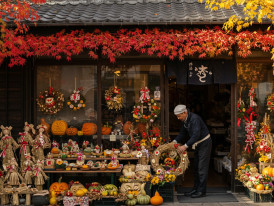
A small local shop front decorated with autumn leaves and displaying seasonal goods, with an elderly shopkeeper arranging items outside
Quiet Neighborhoods: Autumn's True Character
The real character of autumn in Osaka emerges in residential neighborhoods where daily life continues without tourist fanfare. These areas reveal how locals experience the season.
Walking through Sumiyoshi or Tennoji neighborhoods in mid-October, you notice how residents mark autumn's arrival. Small gardens burst with carefully tended color. Laundry hanging on balconies includes heavier clothes. Children walk to school bundled in light jackets, their breath visible in morning air.
These neighborhoods contain hidden gems that reveal themselves gradually. A community center might host traditional craft workshops where elders teach young people to work with materials gathered during autumn walks. These activities connect seasonal rhythms to cultural preservation.
Local souvenir shops adapt their offerings to autumn needs. Hardware stores display rakes and leaf-collecting tools. Clothing shops feature layers appropriate for changeable weather. These practical adaptations reflect deeper cultural awareness of seasonal transitions.
The rhythm of neighborhood life slows in autumn. People spend more time outdoors during pleasant afternoon hours. Evening walks become popular again after summer's oppressive heat. Parks that sat empty during summer heat waves fill with families and elderly residents enjoying cooler air.
Tip
We match you with the right host, not just any guide.Want to experience the real Osaka with someone who lives there?
A fully private experience, planned and led by a local host who tailors the day to you

A small group of people sharing tea outdoors in a park setting with autumn foliage creating a colorful backdrop Photo by Cajeo Zhang on Unsplash
Green Tea Culture: Autumn's Ceremonial Side
Green tea culture takes on special significance during Osaka's autumn season. Appreciating seasonal change becomes central to tea ceremony and casual tea drinking alike.
I learned about tea's seasonal aspects from an elderly neighbor who invited me to informal tea gatherings in her small apartment. She explained how autumn's cooler air affects tea preparation—water temperatures, steeping times, even the choice of cups change with the season.
Tea shops throughout Osaka feature autumn-specific blends that incorporate seasonal ingredients. Some add roasted rice for warming properties, while others include subtle fruit notes that complement autumn's harvest theme. These seasonal variations connect tea culture to agricultural cycles.
The practice of outdoor tea appreciation becomes possible again as temperatures moderate. Small groups gather in parks for informal tea sessions, bringing portable equipment and seasonal sweets. These gatherings combine social connection with seasonal celebration.
Green tea culture in autumn extends beyond formal ceremony to include everyday appreciation. The morning cup takes on a different meaning when enjoyed while watching leaves change color outside apartment windows. These daily rituals create personal connections to seasonal rhythms.
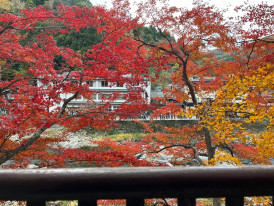
A view from a quiet rooftop garden overlooking residential Osaka with autumn trees creating patches of color among traditional houses. Photo by Hy. on Unsplash
Elevated Views: Autumn from Above
Visiting Osaka's observation decks and elevated spaces provides unique perspectives on autumn's transformation. Beyond famous tourist spots, lesser-known vantage points offer remarkable views.
The Umeda Sky Building remains popular, but timing matters enormously. Early morning visits avoid crowds and capture atmospheric effects as mist rises from warming ground. The city's layout becomes clear from this height—how parks and temples create green corridors that channel autumn color through urban space.
Several Ferris wheel locations throughout Osaka offer rotating perspectives on autumn beauty. The slow movement allows extended appreciation of how autumn affects different neighborhoods simultaneously. From above, you can see how microclimates create variations in leaf timing across relatively small areas.
Less obvious elevated viewpoints include parking garages, apartment building rooftops, and highway overpasses. These utilitarian spaces often provide excellent autumn viewing without crowds or admission fees. The key is knowing where to look and when to visit.
The changing perspective reveals how Osaka integrates natural and built environments—autumn color flowing along river corridors, following train lines, creating unexpected beauty in industrial areas.

A rural autumn festival scene with local residents in traditional clothing celebrating the harvest with seasonal foods and decorations Photo by note thanun on Unsplash
Day Trip Destinations: Autumn Beyond the City
Several destinations within easy day trip distance from central Osaka offer autumn experiences impossible within city limits.
The journey becomes part of the experience as trains carry you through increasingly rural landscapes. Windows frame constantly changing autumn displays—rice fields ready for harvest, forested hills blazing with color, traditional farmhouses surrounded by persimmon trees heavy with orange fruit.
These destinations offer different scales of autumn beauty. Where Osaka provides intimate garden experiences and urban autumn integration, surrounding areas reveal how autumn transforms entire landscapes. For those planning extended stays, you might also consider exploring things to do in Osaka this summer to understand how the city changes between seasons. Mountain areas show dramatic elevation effects—autumn color descending from higher altitudes over several weeks.
Regional specialties become available during these day trip adventures. Local festivals celebrate harvest time with foods and traditions specific to rural areas. These experiences provide context for understanding how urban autumn culture connects to agricultural heritage.
The contrast with city life becomes striking—where Osaka integrates autumn into urban rhythms, rural areas organize entire communities around seasonal transitions.
Ready to plan your perfect day in Osaka?
Start your experience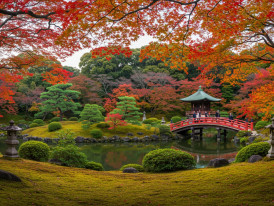
Osaka Garden in summer and autumn
Timing Your Autumn Experience
Understanding autumn's timeline in Osaka enhances every aspect of your visit. The season unfolds gradually, offering different experiences at different times.
Early October brings the first hints—ginkgo trees beginning to yellow, morning air with sharp edges. Mid-October offers the most comfortable weather, perfect for extended walks and outdoor dining. By late November, peak colors create dramatic displays, but crowds return for weekend viewing.
Early December extends autumn's influence even as winter approaches. Many trees remain colorful while others have dropped their leaves, creating layered landscapes that combine seasonal elements. Weather patterns affect timing unpredictably. Warm autumns delay color changes. Early cold snaps can trigger rapid leaf drop before the best foliage develops, so timing becomes part of autumn's adventure.
Local knowledge proves invaluable—asking residents about current conditions often reveals better information than official sources.
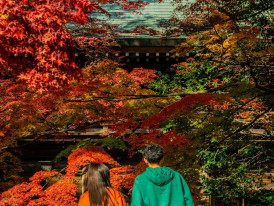
A respectful distance shot of photographers maintaining appropriate boundaries while capturing autumn scenes near a temple area Photo by Tantan Wiguna on Unsplash
Autumn Photography: Capturing Ephemeral Beauty
Photographing autumn in Osaka requires understanding both technical aspects and cultural sensitivity. The goal isn't just documentation, but connection to seasonal beauty.
Light quality changes dramatically during autumn months. Lower sun angles create longer periods of golden hour lighting. Morning mist adds atmospheric effects. Overcast conditions provide even lighting perfect for capturing subtle color variations.
Composition opportunities multiply as autumn progresses. Early autumn offers green-to-gold transitions. Peak color provides dramatic contrasts between colorful leaves and architectural elements. Late autumn reveals structural elements usually hidden by foliage. Each phase requires different approaches and offers unique rewards.
Cultural considerations matter when photographing in Japan. Avoid disrupting ceremonial activities or private moments. Many temple areas restrict photography or require permission. Some gardens have specific opening hours that limit access to optimal lighting conditions. Respecting local customs ensures continued access to beautiful locations.
The best autumn photographs often result from returning to locations multiple times as conditions change—patience rewards photographers with images impossible to plan.

Different types of appropriate footwear for autumn walking in Osaka, arranged on fallen autumn leaves to show seasonal context
What to Pack: Layering for Autumn Comfort
Autumn weather in Osaka requires flexible clothing strategies. Temperature variations within single days can be significant, requiring adaptable layering systems.
Morning temperatures in mid-October might require light jackets, while afternoon sun makes t-shirts comfortable. By late November, proper winter coats become necessary for early morning or evening activities. The key lies in layering options that adapt quickly to changing conditions.
Footwear choices matter enormously for autumn exploration. Fallen leaves create slippery surfaces, especially when wet. Waterproof shoes help during morning dew or afternoon rain showers. Comfortable walking shoes become essential for extended temple and park visits.
Accessories enhance comfort and photography opportunities. Light gloves help during early morning temple visits, and scarves provide warmth during Ferris wheel rides or observation deck visits.
Temperatures ranging from cool mornings to warm afternoons require preparation for 15-20 degree variations within single days.
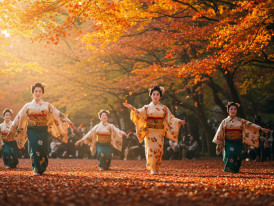
traditional dancers performing outdoors with autumn leaves falling around them, capturing the integration of cultural expression and seasonal beauty osaka
Festival Culture: Autumn's Cultural Celebrations
Autumn festivals throughout Osaka celebrate seasonal transitions with traditions that connect modern life to agricultural heritage. These events offer cultural immersion beyond typical tourist experiences.
The autumn equinox triggers various ceremonial observances throughout the city. Temple areas host special services that mark seasonal transitions. These ceremonies often include community elements—shared meals, traditional music, collective appreciation of natural beauty.
Neighborhood festivals during autumn focus on harvest themes and preparation for winter months. Local food specialties highlight seasonal ingredients. Traditional crafts demonstrate skills needed for seasonal transitions. These events preserve cultural knowledge while building community connections.
Cultural performances during autumn festivals often incorporate seasonal themes. Traditional music reflects natural rhythms. Dance performances celebrate harvest completion. These artistic expressions connect contemporary life to ancient agricultural cycles.
These festivals provide opportunities to experience Japanese culture beyond tourist presentations—participating in community celebrations rather than observing from outside.

An elevated night view of Osaka showing the contrast between illuminated urban areas and darker parks. Photo by Kazuo ota on Unsplash
Evening Autumn: When Osaka Glows
Autumn evenings in Osaka offer unique experiences as shorter days create extended twilight periods perfect for urban exploration.
Street lighting interacts differently with autumn foliage than with summer greenery. Golden leaves reflect warm light, creating atmospheric effects impossible during other seasons. Even neon lights that seem harsh in summer become part of autumn's color palette, their artificial brightness softened by natural seasonal tones.
Evening markets and food areas take on special character during autumn months. Comfortable temperatures encourage leisurely exploration. Steam from cooking food creates atmospheric effects in cooler air. The vibrant nightlife becomes accessible again after summer's oppressive heat, but with autumn's gentler pace rather than summer's frantic energy.
Elevated viewing areas offer dramatic perspectives on autumn evenings. City lights begin early due to shorter days, creating contrast with fall foliage still visible in residual daylight. This transitional lighting creates photographic opportunities unavailable during other seasons.
The combination of cooler temperatures and earlier darkness creates perfect conditions for evening exploration that summer heat and winter cold make uncomfortable.
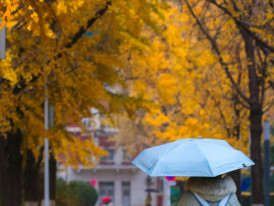
A peaceful autumn scene during light rain with paths and benches empty. Photo by Ming Lv on Unsplash
Finding Solitude: Quiet Spaces in Busy Osaka
Even in Japan's second-largest city, autumn reveals spaces for solitude and reflection. Knowing where and when to look transforms the urban experience.
Early morning hours before business districts activate offer the most reliable solitude. Parks and temple areas remain quiet until mid-morning. Walking residential neighborhoods during these hours reveals Osaka's gentler rhythms—elderly residents tending small gardens, children walking to school, daily life proceeding at human scale.
Certain locations remain consistently less crowded despite offering excellent autumn experiences. Small neighborhood temples, pocket parks, residential areas away from major stations—these spaces provide an authentic local atmosphere without tourist pressure.
Weather can be your ally in finding solitude. Light rain discourages casual visitors but creates atmospheric conditions that enhance autumn beauty. Overcast days provide excellent photography light while reducing crowds at popular viewpoints.
The rare find isn't necessarily hidden locations, but timing your visits to experience popular places during their quiet moments.

A Ghibli-themed area within the park showing autumn decorations and natural elements that connect theme park fantasy with seasonal reality Photo by Moisés Fonseca on pexels
Universal Studios and Ghibli Park: Autumn Theme Park Magic
While theme parks might seem contrary to autumn's contemplative nature, these destinations offer unique seasonal experiences worth considering during your Osaka visit.
Universal Studios transforms completely for autumn celebrations. The wizarding world of Harry Potter takes on a special atmosphere in cooler weather, while Halloween events complement the Harry Potter theme with seasonal excitement. The flying dinosaur and other outdoor attractions become enjoyable again as oppressive summer heat gives way to comfortable temperatures.
Ghibli park elements within the broader Universal experience gain special relevance during autumn. The connection to natural beauty and seasonal change aligns with Studio Ghibli's environmental themes. These attractions feel more authentic when experienced during seasons that emphasize nature's importance.
Theme park visits during autumn offer practical advantages beyond seasonal atmosphere. Cooler weather allows all-day exploration without heat exhaustion. Even artificial environments benefit from autumn's more pleasant conditions.
The Jurassic Park area becomes particularly enjoyable during autumn when outdoor queuing and walking between attractions doesn't involve battling oppressive heat.

A bus traveling through autumn countryside to reach hiking destinations, with passengers visible inside and beautiful fall foliage outside Photo by Tao Yuan on Unsplash
Transportation: Moving Through Autumn Osaka
Visiting Osaka during autumn requires understanding how seasonal changes affect transportation options and timing.
Osaka Station serves as the central hub for autumn exploration, but crowd patterns change significantly during comfortable weather months. Weekend trains to popular autumn destinations fill quickly. Namba Station becomes particularly busy as visitors head toward temple areas and traditional neighborhoods.
Local train lines offer unexpected autumn viewing opportunities. The journey becomes part of the experience as windows frame constantly changing autumn displays. Some routes pass through residential areas where private gardens contribute to overall autumn beauty.
Bus routes to destinations like Minoh Park experience increased demand during peak autumn periods. Planning ahead and considering weekday visits helps avoid crowds. Some locations offer multiple transportation options—comparing train and bus routes can reveal less crowded alternatives.
Purchase tickets for popular destinations in advance, especially for weekend travel during mid to late November when autumn colors peak.

Close-up details of autumn textures - bark patterns, leaf structures, fallen seeds
The Art of Autumn Appreciation
Learning to see autumn properly requires understanding Japanese concepts of seasonal appreciation that extend beyond simple sightseeing.
The concept of mono no aware—awareness of impermanence—becomes tangible during autumn when beauty and transience combine so dramatically. This isn't philosophical abstraction but practical guidance for experiencing seasonal change. Sitting quietly with autumn beauty, accepting its temporary nature, enhances appreciation.
Traditional seasonal awareness extends to subtle details—the sound of leaves underfoot, the scent of autumn air, the quality of light filtering through changing canopy. These sensory experiences become as important as visual beauty when you learn to notice them systematically.
Seasonal appreciation connects to larger cultural patterns of attention and gratitude. Taking time to notice beauty, acknowledging its temporary nature, expressing gratitude for the experience—these practices transform casual sightseeing into meaningful cultural participation.
The wonderful experience comes not from checking locations off lists, but from developing capacity to see beauty that's always present but requires attention to notice.

A historical marker or information sign near autumn trees, explaining the cultural and historical significance of the location and its seasonal traditions Photo by Gang Hao on Unsplash
Autumn's Hidden Stories
Every autumn element in Osaka carries historical and cultural stories that deepen appreciation beyond surface beauty.
The cherry blossoms that define spring tourism tell different stories during autumn. Bare branches reveal tree architecture usually hidden by flowers and leaves. These same trees that create spring celebration become studies in elegant simplicity during autumn's later phases.
Ginkgo trees throughout Osaka connect to deep historical patterns. Many specimens are centuries old, having survived wars, urban development, and environmental change. Their autumn display represents continuity with past generations who appreciated the same seasonal beauty.
Temple gardens preserve traditional relationships between human design and natural processes. The autumn displays result from centuries of cultivation, pruning, and planning. Understanding this historical context transforms casual viewing into appreciation of sustained cultural practice.
Evil spirits, according to traditional belief, cannot cross beautiful natural boundaries—one reason temple gardens emphasize seasonal beauty as spiritual protection.

Local residents and visitors discussing weather patterns and seasonal changes in an Osaka park setting. Photo by Roméo A. on Unsplash
Weather Wisdom: Understanding Autumn's Rhythms
Successful autumn experiences in Osaka require understanding weather patterns that affect both comfort and beauty.
Osaka's autumn weather follows predictable patterns disrupted by occasional surprises. Typhoon season extends into early autumn, bringing dramatic weather changes. These storms often trigger rapid autumn color development as stressed trees respond to environmental pressure.
Micro-climates within the city create variations in autumn timing and intensity. Parks near water bodies maintain different temperatures than urban core areas. Elevated locations experience different wind patterns. Understanding these variations helps optimize timing for specific locations.
Traditional weather wisdom remains relevant for modern visitors. Morning mist often indicates clear afternoons perfect for photography. Wind direction affects which areas will be most comfortable for outdoor activities. Local residents still use these natural indicators alongside modern forecasts.
Amazing time for photography occurs during weather transitions—just after rain stops, as mist clears, during the golden hour before storm systems arrive.

A peaceful final scene showing visitors and locals sharing autumn spaces together, demonstrating how the season brings people together in appreciation of natural beauty Photo by Syadza Salsabyla on Unsplash
Conclusion: Embracing Autumn's Secret Season
After fifteen autumns in Osaka, I'm still discovering new dimensions to this season that feels like the city's best-kept secret. While crowds chase spring's cherry blossoms and summer's festivals, autumn offers something more subtle and perhaps more profound.
The things to do in Osaka this autumn extend far beyond typical tourist activities. They involve learning to see differently, to appreciate layers of beauty that require time and attention to reveal themselves. These Osaka experiences create connections between visitors and the city's deeper cultural rhythms. From the architectural elegance of bare ginkgo trees to the intimate warmth of neighborhood temples, autumn teaches patience and rewards careful observation.
This season connects us to something essential about living in harmony with natural rhythms, even within Japan's second-largest urban area. The autumn leaves that drift across busy intersections, the comfortable temperatures that make street food appealing again, the shortened days that encourage evening exploration—all create opportunities for experiences impossible during other seasons.
It is absolutely worth visiting during autumn, when Osaka reveals its contemplative character and proves that even major cities can maintain deep connections to seasonal beauty and cultural tradition. This season transforms the familiar into something quietly extraordinary.
What if your day in Osaka was planned by someone who knows it — and you?
City Unscripted matches you with a local host who creates a private experience based on your interests, not a set route.
Want to experience the real Osaka with someone who lives there?
A fully private experience, planned and led by a local host who tailors the day to you










